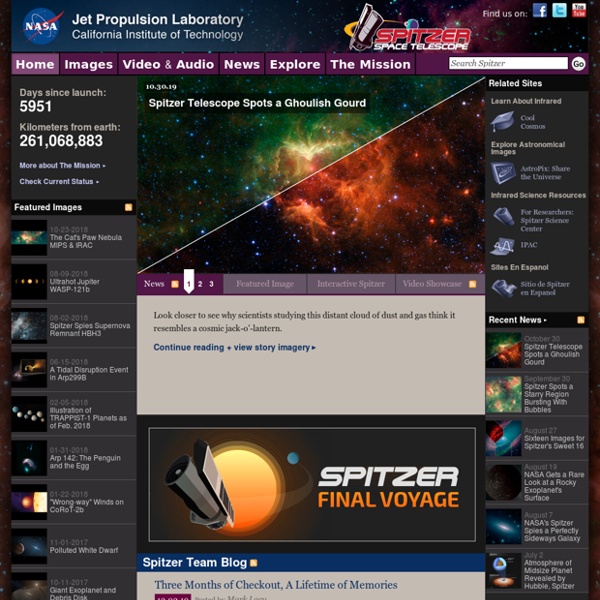



http://www.spitzer.caltech.edu/
Astronomy Picture of the Day Discover the cosmos! Each day a different image or photograph of our fascinating universe is featured, along with a brief explanation written by a professional astronomer. 2016 April 15 Mercury and Crescent Moon Set Image Credit & Copyright: Miguel Claro (TWAN, Dark Sky Alqueva)
Astronomie - MESSENGER arrive aux abords de Mercure - AstroSurf Envoyé 03-01-2008 19:42 j'ai relevé ces precisions sur le site, où il s'avère que c'est bien pour diminuer la vitesse de la sonde afin qu'elle soit capturée par Mercure...Mais ça ne répond pas tout à fait à la question : pourquoi peut-on envoyer directement une sonde en orbite de Mars et pas de Mercure ? Rôle joué par le Soleil, faible masse de Mercure ?? "5.
Astrophysics Astrophysics People have gazed at the stars, given them names, and observed their changes for thousands of years. NASA joined the ancient pursuit of knowledge of our universe comparatively recently. Goals The science goals of Astrophysics are breathtaking: we seek to understand the universe and our place in it. We are starting to investigate the very moment of creation of the universe and are close to learning the full history of stars and galaxies. Red Square Nebula Not to be confused with a similar nebula, the Red Rectangle Nebula. The Red Square Nebula is a celestial object located in the area of the sky occupied by star MWC 922 in the constellation Serpens. The first images of this bipolar nebula, taken using the Mt. Palomar Hale telescope in California, were released in April 2007. It is notable for its square shape, which according to Sydney University astrophysicist Peter Tuthill, makes it one of the most symmetrical celestial objects ever discovered.[1] The explanation proposed by Tuthill and his collaborator James Lloyd of Cornell University claims that the square shape arises from two cone shapes placed tip-to-tip, as seen from the side.
Practical tips By Opal Dunn, educational consultant and author Introduction Young children learn English differently from most adults. Most have an innate ability to pick up English while taking part in activities, by making sense of what they are doing and picking up the adult’s language that accompanies the activity. You can find out more in the British Council booklet ‘How young children learn English as another language’, also available on the parents pages of the LearnEnglish Kids website. Planned English sessions
Hubble data predicts Milky Way galactic collision When Galaxies Collide! It sounds like an early science fiction novel. However, analysis of Hubble measurements shows that our own Milky Way galaxy is moving toward a head-on collision with our nearest neighbor, the Andromeda galaxy (also known as M31). The collision will start in about four billion years, and over the following three billion years the two spiral galaxies will coalesce into a large elliptical galaxy. ISS HD Earth Viewing Experiment on USTREAM: ***QUICK NOTES ABOUT HDEV VIDEO*** Black Image = International Space Station (ISS) is on the night side of the ... Black Image = International Space Station (ISS) is on the night side of the Earth. No Audio = Normal. There is no audio by design.
Great Attractor Panoramic view of the entire near-infrared sky. The location of the Great Attractor is shown following the long blue arrow at bottom-right. The Hubble Telescope turned its lens to the region of the sky where the Great Attractor is located. The Great Attractor is a gravity anomaly in intergalactic space within the range of the Hydra-Centaurus Supercluster that reveals the existence of a localized concentration of mass equivalent to tens of thousands of galaxies, each of which represents the mass of the Milky Way; this mass is observable by its effect on the motion of galaxies and their associated clusters over a region hundreds of millions of light-years across. These galaxies are all redshifted, in accordance with the Hubble Flow, indicating that they are receding relative to us and to each other, but the variations in their redshift are sufficient to reveal the existence of the anomaly.
New Study Challenges Planck Results cosmic microwave backgroundA new view of the cosmic microwave background, as seen over the whole sky with the Planck satellite. Although analyses of this image indicate complete agreement with the simple model of a big bang inflation, a new paper suggests the agreement is so perfect that it is very unlikely the inflation model is actually the correct one. Credit: ESA/Planck A new study from researchers at the Harvard-Smithsonian Center for Astrophysics challenges the inflation model, arguing that the new Planck results are actually too good.